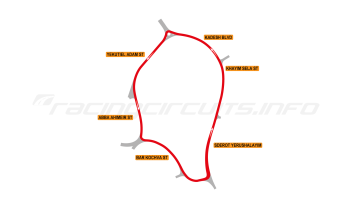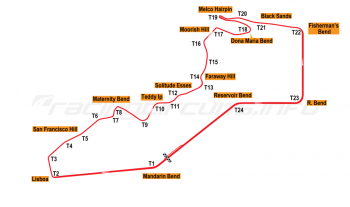Adria International Raceway
Circuit Overview
Adria Raceway will probably never enter the pantheon of great circuits thanks to its tight and twisty nature, though there are plenty of other circuits that can only look on with envy at the pit and paddock facilities, which are truly first class. Indeed, the track can boast to being the only racetrack in the world equipped with a covered paddock.
The original layout attempted to pack a lot into a relatively small space, being essentially a series of straights connected by tight hairpins. However, the 2021 redesign includes even more, with a further series of infield loops added to create a dizzying series of switchbacks, before an extended back straight was connected to the final few curves of the original course via a tight 'street' section which has the barriers in close proximity.
Recent years have seen the Italian national championships as mainstays of the racing calendar, with Formula Two and Formula Abarth among the visitors. Track days and driver training events make up the remainder, alongside manufacturer days and general testing.
Circuit History
The circuit near Venice opened in 2002 after several years of planning. Initially, the course was to have featured a completely different design on a plot on the opposite site of the Canal Bianco. However, the eventual location presented its own challenges, being a rather small plot on which to create an international racing circuit. The designers did what they could, creating a circuit which twists back on itself in several places, with the straights connected by a series of hairpin bends.
With a distinct lack in elevation changes and few high speed corners, the result is a track that is unlikely to set many drivers' pulses racing, though it does require a certain amount of finesse on braking and good traction in order to get a good lap time. Two further circuit variants were also created; a short course which cut out the back straight section and a second testing loop (known as the 'Dog Bone' thanks to its shape) which could be artificially watered for wet weather simulation. Both short courses could run simultaneously while the main course was homologated to Formula One Testing standards.
The circuit's standout feature – and perhaps the reason why it gained some prestigious fixtures in its early years – is the covered paddock area. In a giant-sized hall, the race transporters can be parked directly behind the pit boxes, providing an air-conditioned area in which to work and entertain guests. When not in use for racing the hall is unsurprisingly used an exhibition venue, providing a considerable amount of the circuit's income each year.
International stars arrive
The German DTM touring car championship was the first international series to visit Adria, hosting races in 2003 and 2004. In the inaugural year, victory went to Dutch driver Christijan Albers (Mercedes-Benz). In 2004, eventual champion Mattias Ekström (Audi) managed to win the race at the compact circuit before the DTM abandoned its Italian fixture for several years.
In the DTM's place came the FIA GT Championship, hosting a three-hour race in 2006 and then switching to a two hour night race in 2007 and 2008. Somewhat unexpectedly, the DTM returned in 2010, though the race was mainly memorable for the gigantic crash of Alexandre Premat, who flipped his Audi on the start-finish straight after contact from the Mercedes of Maro Engel. Despite cartwheeling with parts flying in numerous directions, the Frenchman emerged unscathed.
In 2012, the circuit underwent its first modifications when a new first corner hairpin was installed for use by motorbike racers. This brought the first turn closer to the pit and paddock and in turn increased the amount of run-off available for the first corner. The original track remains unaltered for continued use in four wheeled competition, though the changes did effectively spell the end of the use of the 'Osso di Cane' test track, thanks to the new corner cutting across it rather abruptly.
Extensive changes lengthen the course
More ambitious alterations were first announced in May 2020, with plans to extend the circuit to more than 4km in length. In parallel, Eurosport Events, promoters of the FIA WTCR championships announced that the revised circuit would play host to the 2020 season finale in November the same year. The ambitious plans for the new circuit seemed shrouded in secrecy and, with the coronavirus pandemic hitting Italy particularly hard, progress stalled, to the extent that the WTCR race was switched to Motorland Aragon as early as August.
Nevertheless, the circuit did persevere and work to construct the completely revised course began in earnest over the winter of 2020, with surfacing work taking place in late January 2021. This revealed the shape of the new course, designed by Italian specialists Dromo, with multiple switch loops backs in the centre emptying out onto a new back straight. This rejoins the original course after dipping behind the existing tree line through a series of bends. If the old layout was considered tight and twisty, the new one doubles down on this and more! An outer loop is also available to bypass the infield back-and-forth section.
Progress has been sufficient enough for the WTCR promoter to re-instate Adria for 2021, adding the Venetian track in place of the Slovakiaring when an amended season calendar was announced in January 2021. The revised circuit played host to the Race of Italy round in November, though Adria was not included when the calendar for 2022 was released and it remains to be seen if the WTCR or other international series will return.
Jump onboard
Circuit info
- Adria International Raceway, Località Smergoncino, 7, 45011 Adria RO, Italy
- +39 0426 941
- Email the circuit
- Official website
Rate This Circuit
Votes: 4790
Get your race tickets!
Brought to you with: 
We've teamed up with Motorsports Tickets to bring you the best deals for Formula One, MotoGP, Le Mans and more.
















